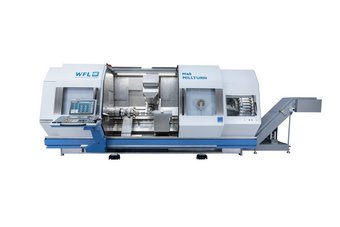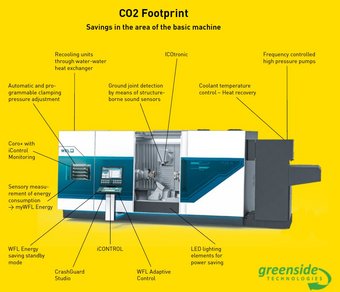A green machine
WFL takes its responsibility for the sustainability of the company and its activities very seriously and has done so for many years. Since customers are increasingly factoring sustainability into their purchasing decisions, WFL continues to pursue this path.
The ever increasing environmental damage and its negative effects are a call to action. Our fossil fuel reserves will start to run out sooner or later, which will go hand in hand with rising energy prices. This has prompted companies to fundamentally rethink their approach to business. Sustainability in industrial production has therefore become a
decisive matter when it comes to the future. Specific projects for reducing or preventing CO2 emissions have already been developed. Clear aims and measures help WFL to continually improve its sustainability and energy efficiency.
Greenside Technologies
Greenside Technologies enables machines to be put into energysaving mode (the hydraulics, pneumatics, lighting, drive supply, cooling system, etc. are deactivated) during the production process (after completion of the workpiece in the commissioning) when they are not in use.
Savings in machine technology
Only energy-efficient components with the option of energy recuperation or use of waste heat are used in the MILLTURN turning-boring-milling centres. Frequency-controlled pumps are used alongside highly energy-efficient motors and drives, meaning that electricity is drawn only in the exact amounts required. When the spindle drives brake, the machine works as a generator and feeds valuable electrical energy back into the grid. The additional energy-saving standby mode for organisational downtimes requires around 65% less energy compared to conventional idling.
The number of WFL energy-saving features is clear to see:
- WFL energy-saving standby mode
- Frequency-controlled high-pressure pumps
- Cooling units through water-to-water heat exchangers
- CrashGuard Studio – preliminary simulation without machine operation
- WFL Adaptive Control – fewer non-productive machine movements
- Process monitoring – more efficient machining processes and less damage
- Machine room lighting with LEDs in place of halogen and fluorescent lamps
Example energy-saving calculation
WFL after-work mode / energy-saving mode: M40 MILLTURN / 2000mm
Calculated for an example company:
- 52 weeks of production per year
- 5 days of production per week
- 2 shifts per day
- Reduction in consumption due to energy-saving mode on average around ~6 kW
Savings:
6 kW x (8 h x 5 + 24 h x 2) x 52 = -27.456 kWh / -13,9t CO2



